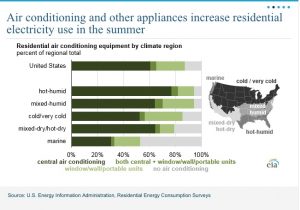The US Energy Information Agency shared the results of its Residential Energy Consumption Survey and it demonstrates why Smart Homes must be a priority to maximize energy efficiency. The survey found that 103 million (87%) of the 118 million households in the US had air conditioning and, of those, 48.5 million (47%), had a programmable thermostat to control the AC. The rest use a simple thermostat (27%) or turned their AC on and off as needed.

As disappointing as it might be that only 47% of homes with AC have programmable thermostats, it is even worse that only about 14 million (12%) actually use them to control their air conditioners. The result is that in the US, AirCons are often running, whether or not anyone is home. And even programmable thermostats can be terribly inefficient if the thermostat isn’t manually adjusted to account for going away on vacation or leaving the house for extended periods during the day.
That’s where Smart Homes comes in
The Smart Home can learn your schedule, adjust to extended absences, anticipate your return, and by sparing the homeowner from even having to think about economizing, optimize efficiency, cost, and comfort.
Of course, although this particular survey only looked at AirCons, a really Smart Home would think far beyond that. Just as the Smart Home would optimize cooling, it would also ensure efficient heating in the colder months. And your Smart Home would compensate for distracted family members forgetting to turn off lights when they leave a room; run appliances at off-peak hours, when electricity rates are lower; open and close blinds to optimize natural heating and cooling; and manage the efficiency of the home as its full-time job. It would also provide additional security for the occupants, as it could monitor doors and windows and observe people and animals coming and going while monitoring for flooding, gas leaks, and fires.
Smart Home Savings
So what can all this save? Well, the National Academy of Sciences says that heating and cooling use about 39% of a home’s energy and one manufacturer, Nest, estimates that its thermostats save $131-$145 per year for the average home. Smart Lighting can easily save 75%-80% of lighting costs (7% of home energy costs). Beyond these, with the Smart Home never sleeping and always keeping an eye out for danger, there is the incalculable cost of your family’s safety and security.
ST is a pioneer in Smart Homes. To see where we lead and how we can help, see the Smart Homes pages on ST.com, see us at the ST Developers Conference in Santa Clara on September 6, or check out the Smart Home and DevCon articles we’re posting on the blog.




